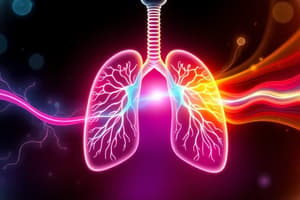Podcast
Questions and Answers
What is the primary source of energy for living organisms?
What is the primary source of energy for living organisms?
- Photosynthesis in non-green plants
- Consumption of water
- Oxidation of macromolecules (correct)
- Respiration without oxygen
Which organisms are capable of preparing their own food through photosynthesis?
Which organisms are capable of preparing their own food through photosynthesis?
- Non-green plants and animals
- Only green plants and cyanobacteria (correct)
- Fungi and bacteria
- All plants and animals
Which part of green plants contains chloroplasts necessary for photosynthesis?
Which part of green plants contains chloroplasts necessary for photosynthesis?
- Superficial layers of leaves (correct)
- Roots and stems
- Non-green tissues
- Roots and flowers
What must occur for non-green parts of a plant to obtain energy?
What must occur for non-green parts of a plant to obtain energy?
What is the term used for organisms that obtain their food from other organisms?
What is the term used for organisms that obtain their food from other organisms?
What does glycolysis primarily involve?
What does glycolysis primarily involve?
What is the primary function of cellular respiration in plants?
What is the primary function of cellular respiration in plants?
Where does glycolysis occur in living organisms?
Where does glycolysis occur in living organisms?
Where does the process of cellular respiration primarily take place in eukaryotic cells?
Where does the process of cellular respiration primarily take place in eukaryotic cells?
What are the byproducts of glucose combustion during glycolysis?
What are the byproducts of glucose combustion during glycolysis?
Which of the following is a correct statement regarding anaerobic organisms?
Which of the following is a correct statement regarding anaerobic organisms?
What do plants predominantly utilize as respiratory substrates?
What do plants predominantly utilize as respiratory substrates?
What is the main source of glucose for plants during glycolysis?
What is the main source of glucose for plants during glycolysis?
Which statement describes gas exchange in plants?
Which statement describes gas exchange in plants?
What is the initial step of glucose breakdown in cellular respiration known as?
What is the initial step of glucose breakdown in cellular respiration known as?
What is the primary purpose of writing effective multiple choice questions?
What is the primary purpose of writing effective multiple choice questions?
Which characteristic is important for the options of a multiple choice question?
Which characteristic is important for the options of a multiple choice question?
How should a stem of a question be constructed?
How should a stem of a question be constructed?
What should be avoided when constructing the options for a question?
What should be avoided when constructing the options for a question?
Why should distractors represent common misconceptions?
Why should distractors represent common misconceptions?
Flashcards are hidden until you start studying
Study Notes
Cellular Respiration in Plants
- Cellular respiration breaks down food molecules to release energy.
- This occurs in the cytoplasm and mitochondria of eukaryotic cells.
- Energy is released in controlled steps catalyzed by enzymes and trapped as ATP.
- Carbohydrates are the primary energy source for plants.
Gas Exchange in Plants
- Plants do not have specialized respiratory organs like animals.
- Stomata and lenticels facilitate gas exchange in plant parts.
- Gas exchange is mainly required during photosynthesis.
- Plants have a lower need for gas exchange compared to animals.
Glycolysis
- Glycolysis involves splitting glucose into pyruvic acid.
- It is a fundamental process in both aerobic and anaerobic respiration.
- It is also referred to as the EMP pathway.
- In anaerobic organisms, glycolysis is the sole process of respiration.
- Glycolysis occurs in the cytoplasm of all living organisms.
- Glucose is partially oxidized to form two pyruvic acid molecules.
- Plants obtain glucose from sucrose (photosynthesis product) or storage.
Important Considerations
- Gas Diffusion: Plant structures facilitate gas diffusion, especially with cells being close to the surface.
- Cell Organization: Cells in stems are organized in layers, with some dead for structural support, not photosynthesis.
- Energy Production: Glucose combustion yields energy, $CO_2$, and $H_2O$ as byproducts. The goal is controlled energy release.
- Anaerobic Conditions: Some organisms have evolved anaerobic respiration, using partial oxidation of glucose without oxygen, like in glycolysis.
Studying That Suits You
Use AI to generate personalized quizzes and flashcards to suit your learning preferences.




